- Details
W6YX Hiking Trip to Black Mountain
April 28th, 2024
We had a great time on our hiking trip to the summit of Black Mountain on Sunday, April 28th, 2024. We brought a QDX radio, an End-Fed three-band antenna built by KO6ECC, and a laptop computer running WSJT-X and GridTracker. The portable End-Fed antenna was supported on one end by a rope tossed over a tree branch. The other end was connected to the QDX radio resting on the ground.



The 10m band was working well that day. We called CQ on 10m FT8 using KO6ECC's and KI6Q's call signs. PSKreporter showed our signals were received as far away as Australia. The maps below show all the stations that reported hearing us.
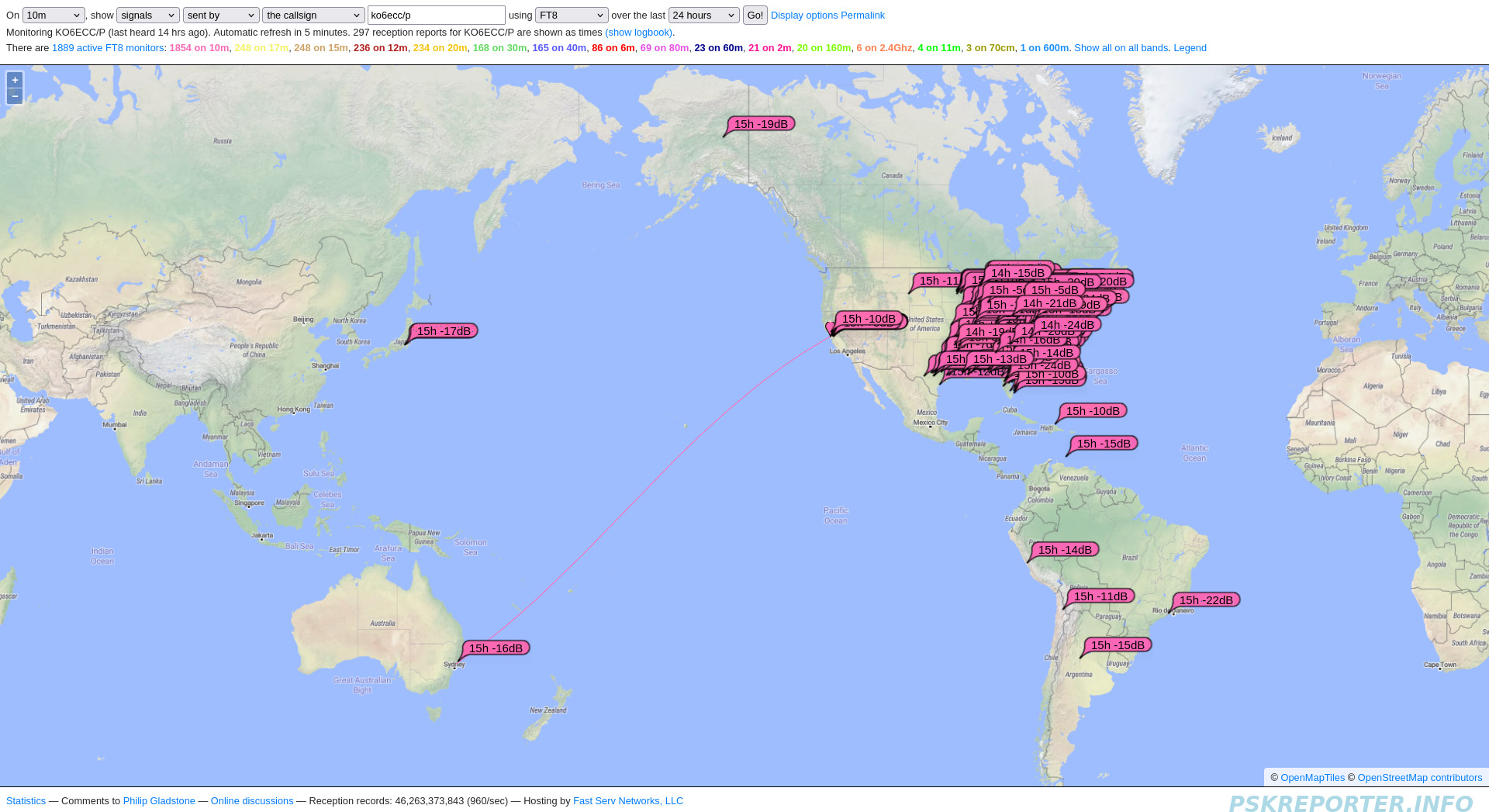
Several stations replied to our CQ, and we also tried replying to CQ's from other stations. We were able to make contacts with the six stations listed below.
| Call | Location | Sent | Rcvd | Station | Mode | Band | Time |
| KF9UG | EN71 | 8 | -6 | KO6ECC/P | FT8 | 10m | Sun 28 Apr 2024 19:45:15 UTC |
| K4NAL | EM60 | 6 | -21 | KO6ECC/P | FT8 | 10m | Sun 28 Apr 2024 20:05:45 UTC |
| KB4WT | EM95 | -6 | -12 | KO6ECC/P | FT8 | 10m | Sun 28 Apr 2024 20:12:00 UTC |
| K0ZS | EM48 | 8 | 9 | KO6ECC/P | FT8 | 10m | Sun 28 Apr 2024 20:27:45 UTC |
| CO2LKY | EL83 | 8 | -8 | KO6ECC/P | FT8 | 10m | Sun 28 Apr 2024 20:38:15 UTC |
| KJ5EJV | EM00 | -3 | -20 | KI6Q/P | FT8 | 10m | Sun 28 Apr 2024 20:43:00 UTC |
| KF9UG | EN71 | 8 | -8 | KI6Q/P | FT8 | 10m | Sun 28 Apr 2024 20:51:30 UTC |
| KF9UG | EN71 | 15 | -9 | KG4UHM/P | FT8 | 10m | Sun 28 Apr 2024 21:05:15 UTC |
The map below shows the locations of our six contacts, highlighted in yellow. Our location was grid square CM87, highlighted in orange.
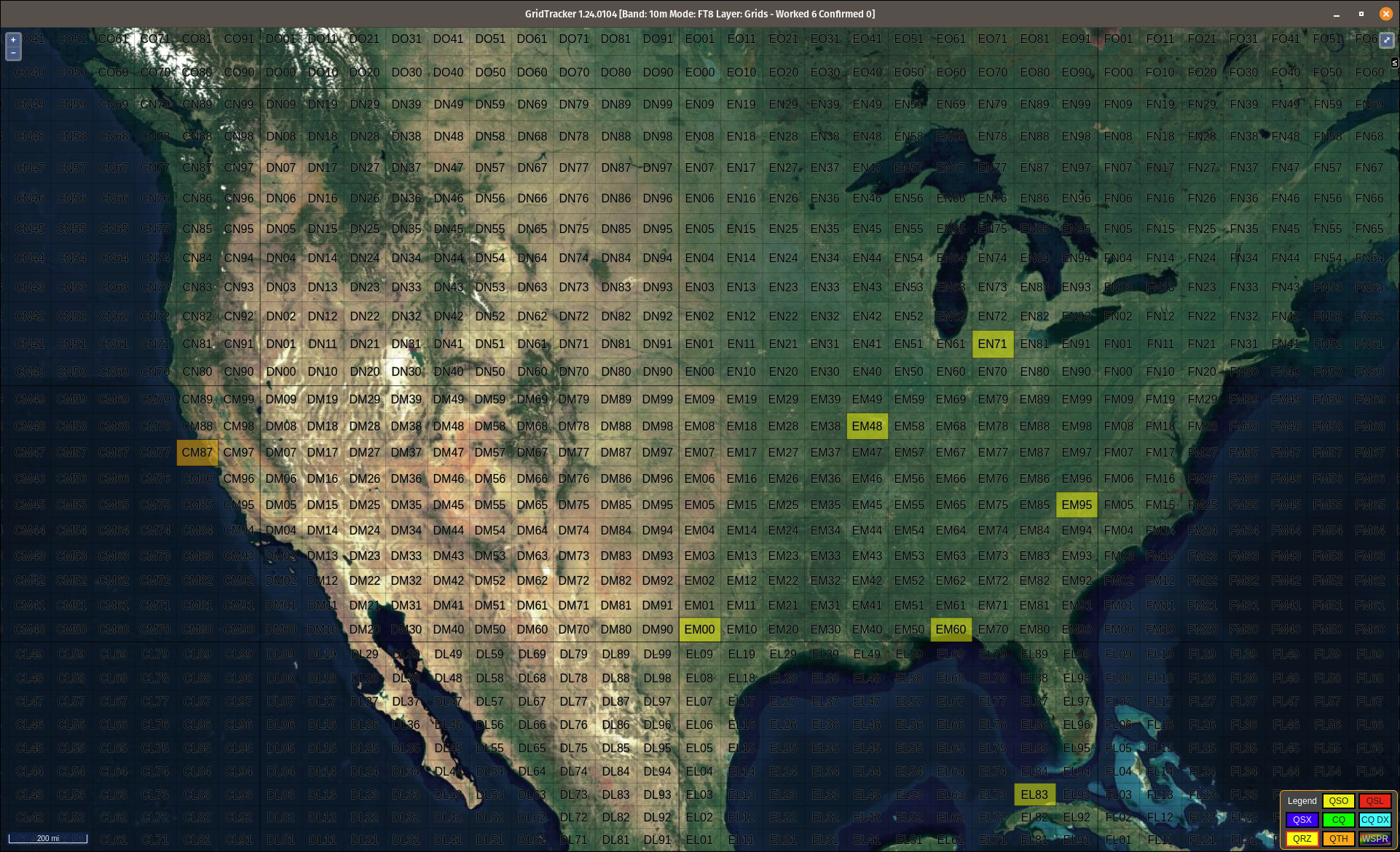
Below is a screenshot from the laptop showing our contact with CO2LKY in Cuba. The program on the right is WSJT-X. The yellow highlited lines are the signals that we transmitted. The red highlighted lines are the replies to us from other stations.
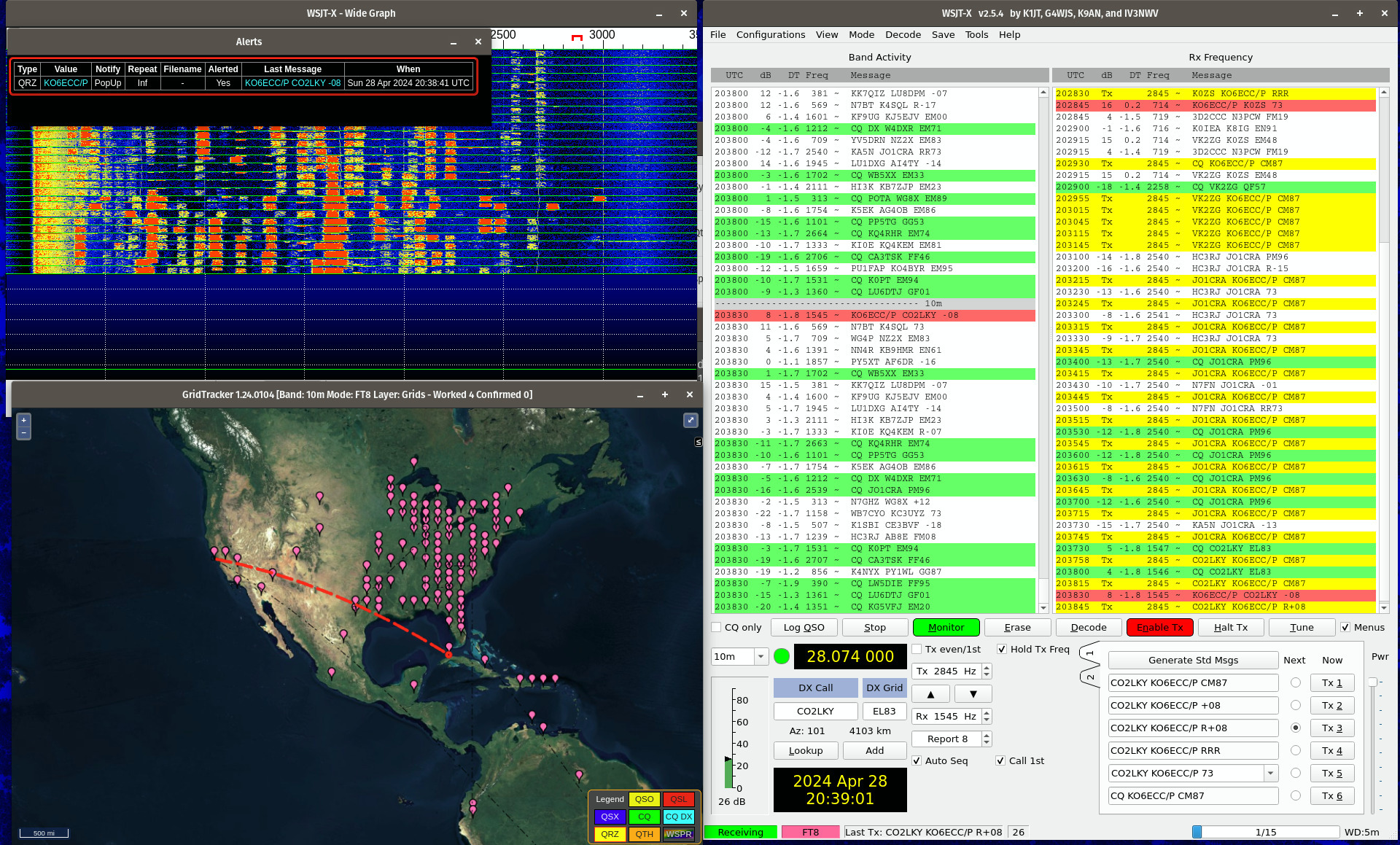
Overall it was a fun day and great opportunity to learn about HF propagation, test our radio skills, and experiment with homemade radios and antennas.
- Details
W6YX Hiking trip to Black Mountain
Sunday, April 28th, 2024, 9:30am to 4pm
Driving time to trail entrance: 30min
Hiking Time: 45min up, 45min down
Hiking Distance: 4 miles round trip
Hiking Altitude Change: 700 feet
We'll be hiking to the summit of Black Mountain this Sunday, April 28th, 2024, to operate portable radios and antennas. We'll try making voice, digital, and CW contacts, and perhaps try making contacts using solar power as well. If conditions are good, we should be able to make contacts up to several thousand miles away.
We plan to meet at the Tresidder parking lot at 9:30am and decide which cars to take. We'll leave Tresidder at 10am and drive to the Monte Bello Preserve parking lot on Page Mill. From there, we'll hike 2 miles to the summit.
We will eat lunch after we get to the summit, so please bring a packed lunch and one or two bottles of water with you. There is a latrine at the Black Mountain Backpack Camp, a short hike from the summit. Also, remember to dress warmly with multiple layers.
Schedule for Saturday, April 28, 2024, 9:30am to 4pm
09:30 am - Meet at Tresidder parking lot.
10:00 am - Depart Stanford Campus.
10:30 am - Arrive at trailhead. Start hike.
11:30 am - Arrive at summit. Set up equipment.
12:00 pm - Start making contacts.
12:30 pm - Lunch.
02:00 pm - Pack equipment.
02:15 pm - Start hike back down.
03:00 pm - Return to trailhead. Drive back to campus.
03:45 pm - Arrive back at campus.
Radio Equipment to bring:
- Charged handheld radio, e.g. Baofeng UV-5R.
- Log book or logging app.
Clothing:
- Non-cotton layers, including a windbreaker.
- Raincoat (just in case).
- Hiking boots / sturdy shoes.
Food and Water:
- Two liters of water.
- Lunch.
- Trail mix and/or Granola Bars.
- Details
Build Your Own Portable Antenna for the QDX Radio
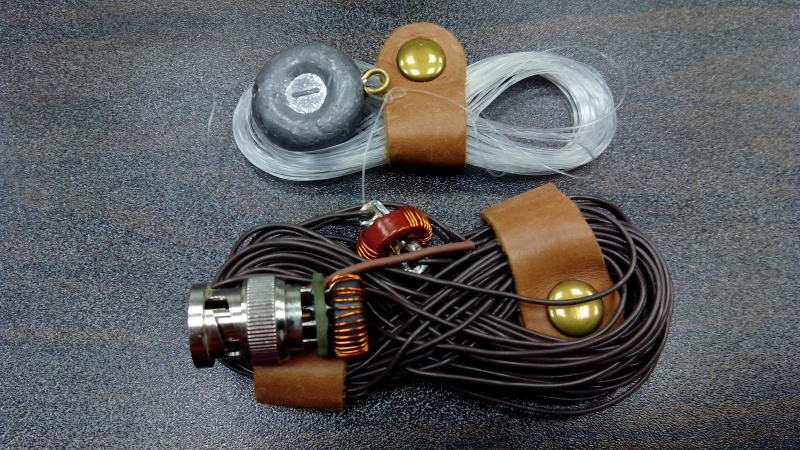 |
Where:
|
Join the Stanford Amateur Radio Club for a weekly activity starting April 13th, 2024, from 1pm-3pm during Maker Jam in Lab64, Packard Building, Room 134.
Learn about End-Fed Half-Wave (EFHW) antennas and learn how to simulate and build a portable EFHW antenna for your QDX radio kit. Make your QDX radio into a fully portable Ham Radio station that you can take with you anywhere. I've used my portable EFHW antenna to make contacts several thousand miles away with my QDX radio while on hiking trips (see pictures below).
If you've already built a QDX kit, this antenna makes a great addition. If you haven't built a QDX kit, you are still welcome to join us and learn more about antennas.
The activity will last three Saturdays in April, and may continue into May if people need more time to finish building their antennas.
I hope to see you all there!
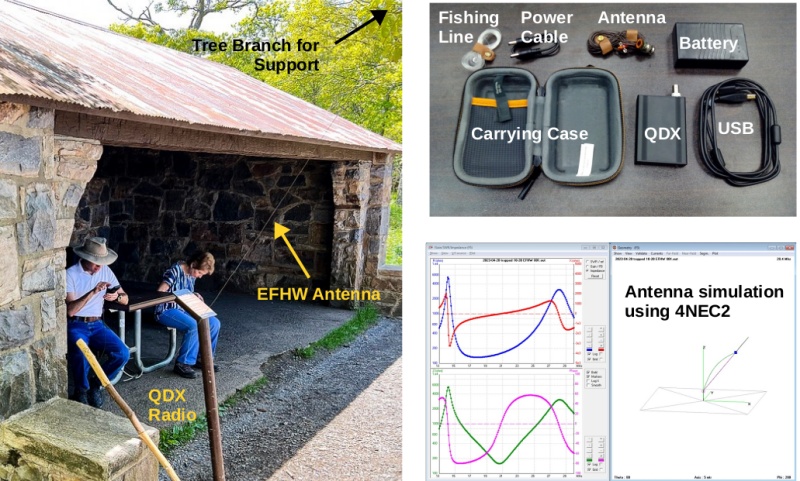
If you are interested in participating, please e-mail me at:

- Details
Save money by joining the bulk-orders for items below. (RSVP by March 27th)
| Kanga Products EFHW antenna kit approx. $34 ea. Good for portable operation |
| ARRL EFHW antenna kit approx. $85 ea. Good for fixed installation at home |
| Minimalist End Fed Half Wave antenna approx. $10 Build a minimalist EFHW from parts. May include 3D printing strain relief. We'll design this ourselves, so final price may vary. Details TBD. |
| QDX radio kit approx. $84 ea. Some extra kits are left over from activity last quarter. |
| Coax Jumper Cable approx. $10 ea. For connecting antenna to radio |
| USB-B to USB-C adapter cable $17 ea. For connecting the QDX radio to a computer. |
| 12V Rechargable Battery approx. $28 ea. Good for powering the QDX radio for portable operation. |
| Typical Combinations | ||
| Basic option | Portable option | High-Performance home station |
(materials for dipole antenna included) |
|
|
| *You can use the USB-B to USB-C adapter cable shown above, or you can use an old USB-B to USB-A cable from a printer if you have a spare. |
Quick summary:
- The Stanford Amateur Radio Club will hold weekly workshops (Saturdays, 1pm-3pm) to build antenna and radio kits, starting in Spring Quarter.
- Beginners are welcome. We'll have experienced mentors to guide you.
- You'll learn about radio waves, the ionosphere, antenna tuning, impedance matching, and antenna efficiency.
- We'll place a bulk order for the kits in the last week of March. For some items, we get a bulk discount.
- Contact me by March 27th if you are interested in joining the bulk orders. Let me know what items you are interested in.
- If you built a QDX radio kit last quarter, this is a good opportunity to build an antenna for it. If you didn't build a QDX kit last quarter, we still have some kits available.
- You'll keep your kit(s) at the end of the workshop.
The Stanford Amateur Radio Club will be holding a weekly kit-building workshop on Saturdays, 1pm-3pm, starting in the Spring Quarter. Last quarter, we built the QDX radio kit. The antenna kits and accessories above make nice additions to the QDX. The End-Fed Half-Wave (EFHW) antenna is the most popular antenna for portable operation, and can also be used for easy multi-band operation from a fixed location.
The EFHW consists of long wire (red wire in the photo above). One end is connected to a transformer (gray box) which connects to your radio. The other end is elevated above the ground using some support like a tree branch. We'll be placing orders for EFHW kits and parts. Let me know if you are interested in building one or more of the kits listed above.
The EFHW can be very lightweight and portable, but it needs a lot of space to deploy. A more compact antenna option is the magnetic loop antenna, like this one we built in 2021 for the 20m band (see below). We plan to get some parts to build an even more compact magnetic loop for the 10m band. Let me know if you are interested in helping design and build this antenna for club use and/or if you are interested in building one for yourself.
We also have some extra QDX radio kits from Winter Quarter. If you are interested in building one of these QDX radio kits let me know. Also, if you ran out of time and didn't complete your QDX kit from last quarter, we'll have mentors available to help you complete it at our Spring Quarter workshops, Saturdays 1pm-3pm. To use the QDX radio on your own, you'll need an Amateur Radio license, which requires passing a multiple-choice test, available online. For those who are not yet licensed, we'll help you study and pass your license test. Prof. Pauly's lecture slides from last quarter's license class are available here.
- Details
Save money by joining the bulk-order for kits (will place order in mid-December)
| QDX parts, case, and pdf manual |
| Completed QDX circuit board |
| Completed QDX kit in aluminum case |
Quick summary:
- We'll hold weekly workshops (Saturdays, 1pm) to build radio kits, starting January 14th
- Beginners are welcome. We'll have experienced mentors to guide you.
- Each kit costs $69 for the board+parts, and $20 for the case.
- We'll place a bulk order for the kits in mid-December. We get a 10% discount if we order 10 or more.
- E-mail me (preferably by Dec. 11th) if you are interested in joining the bulk order.
- You'll keep your kit at the end of the workshop.
The Stanford Amateur Radio Club will be holding a weekly kit-building workshop starting in the Winter Quarter in January. We'll be working together to build our own personal QDX radio kits from QRP Labs. The QDX is a small radio, the size of a deck of cards, which can be used to communicate over thousands of miles by bouncing radio signals off of the ionosphere.
The screenshot below shows all the stations that heard me transmitting using a battery-powered QDX kit and a loop antenna in my living room in Palo Alto. Stations that heard me are the ones with time-stamps. My station was heard as far as Japan, Australia, New Zealand, and the Azores Islands.
The QDX requires a computer (or any computing device, like a Raspberry Pi) to encode and decode the digital signals sent over the air. There are many free Amateur Radio software options that are popular. The screenshot below shows an example of the JS8Call software. This software offers functionality similar to e-mail and text messaging, but it runs entirely over the air, with no need for cell or ISP infrastructure. The screenshot below shows a chat between myself (KG4UHM) in California and another station (KL7DT) located in Alaska.
